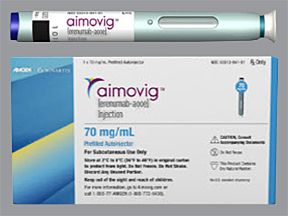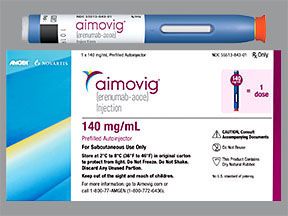Aimovig (erenumab-aooe) is a prescription brand-name medication. The Food and Drug Administration (FDA) has approved it to prevent migraine headaches in adults.
Aimovig comes as a liquid solution, in a prefilled autoinjector pen, that you’ll inject yourself.
Erenumab-aooe (the active drug in Aimovig) is a type of
Aimovig is a brand-name medication. It’s not available in a
Dosage summary
The chart below summarizes Aimovig’s dosage. Your doctor will determine the best dosage for you.
| Aimovig forms | Aimovig strengths | Typical dosage | Maximum dosage |
| • a single-dose prefilled SureClick auto-injector pen • a single-dose prefilled syringe | • 70 milligrams per 1 milliliter (mg/ml) of liquid solution • 140 mg/ml | 70 mg once per month | 140 mg once per month |
For specific information about the dosage of Aimovig, as well as its strengths and how to take the drug, keep reading. For a comprehensive look at Aimovig, see this article.
This article describes typical dosages for Aimovig provided by the drug’s manufacturer. When taking Aimovig, always follow the dosing instructions prescribed by your doctor.
If you’re considering starting treatment with Aimovig, you may have questions about its usual dosage.
Aimovig form
Aimovig is given as a subcutaneous injection once per month.
The medication comes as a liquid solution, in a prefilled autoinjector pen, that you’ll inject yourself. You’ll push the autoinjector pen against your skin, and it’ll inject the medication automatically.
Before you start Aimovig treatment, your doctor or another healthcare professional will show you how to give yourself the injections.
Each Aimovig autoinjector pen contains one dose and is meant to be discarded after each use.
Aimovig strengths
Aimovig is available in two strengths: 70 milligrams per milliliter (mg/mL) and 140 mg/mL.
Typical dosages
Usually, your doctor will start you on a low dosage. Then, they’ll adjust it over time to reach the amount that’s right for you. Your doctor will ultimately prescribe the smallest dosage that provides the desired effect.
The following information describes dosages that are commonly used or recommended. However, be sure to take the dosage that your doctor prescribes for you. Your doctor will determine the best dosing schedule to fit your needs.
The usual starting dose of Aimovig is 70 milligrams (mg) once per month.
During Aimovig treatment, it’s a good idea to keep track of how many days per month you experience migraine headaches. Sharing this information with your doctor will help determine how effective this starting dosage is for your condition.
If the starting dosage doesn’t work well to prevent your migraine headaches, your doctor may increase your dosage of Aimovig to 140 mg once per month.
It’s important to use Aimovig according to your doctor’s instructions. You shouldn’t change your dosing frequency on your own. If you have questions about your dosage, talk with your doctor or pharmacist.
Children’s dosage
Aimovig is only approved for use in adults ages 18 years and older. The drug hasn’t been studied in children.
Long-term use
Aimovig is meant to be used as a long-term treatment. If you and your doctor determine that Aimovig is safe and effective for you, you’ll likely use it long term.
If you miss a dose of Aimovig, you should have it as soon as possible. Then, your next dose will be one month later. Be sure to keep track of the new date so that you have your injections on the same date each month.
For example, let’s say you usually use Aimovig on the first of every month. But you forget to have your dose on September 1. On September 4, you remember and have your dose. In this case, your next dose will be due on October 4.
To help make sure that you don’t miss an Aimovig injection, try using a medication reminder. Consider setting an alert or downloading a reminder app on your phone. A note on your calendar can work, too.
Aimovig is given as a subcutaneous injection once per month. It comes as a liquid solution in a prefilled autoinjector pen. You’ll push the autoinjector pen against your skin, and it’ll inject the medication automatically.
You can inject your Aimovig doses into your thigh or abdomen. If you use your abdomen, you shouldn’t inject Aimovig within two inches of your belly button. If someone else is giving you the injection, the outer area of your upper arm is also an option.
You shouldn’t inject Aimovig into areas of skin that are tender, bruised, or hardened. You should also avoid areas with irritation, scars, or stretch marks.
Before your first dose, your doctor or pharmacist will go over how to inject Aimovig. Detailed guides and video instructions are available on the drug manufacturer’s website.
Each Aimovig autoinjector pen contains one dose and is meant to be discarded after each use.
It’s important that you don’t use more Aimovig than your doctor prescribes. For some medications, taking more than the recommended amount may lead to side effects or overdose.
If you use more than the recommended amount of Aimovig
Call your doctor right away if you believe you’ve used too much Aimovig. Another option is to call the American Association of Poison Control Centers at 800-222-1222 or use their online tool. If you have severe symptoms, immediately call 911 or your local emergency number, or go to the nearest emergency room.
The dosages in this article are typical dosages provided by the drug’s manufacturer. If your doctor recommends Aimovig for you, they will prescribe the dosage that’s right for you. Always follow the dosage that your doctor prescribes for you.
As with any drug, never change your dosage of Aimovig without your doctor’s recommendation. If you have questions about the dosage of Aimovig that’s right for you, talk with your doctor.
Besides learning about dosage, you may want other information about Aimovig. These additional articles might be helpful to you:
- More about Aimovig. For information about other aspects of Aimovig, refer to this article.
- Side effects. To learn about side effects of Aimovig, see this article. You can also look at Aimovig’s prescribing information.
- Details about migraine. For details about migraine, see our migraine hub, as well as this list of related articles.
Disclaimer: Medical News Today has made every effort to make certain that all information is factually correct, comprehensive, and up to date. However, this article should not be used as a substitute for the knowledge and expertise of a licensed healthcare professional. You should always consult your doctor or another healthcare professional before taking any medication. The drug information contained herein is subject to change and is not intended to cover all possible uses, directions, precautions, warnings, drug interactions, allergic reactions, or adverse effects. The absence of warnings or other information for a given drug does not indicate that the drug or drug combination is safe, effective, or appropriate for all patients or all specific uses.


